-
current
recommendations- Liefdefjord
New page dedicated to one of Spitsbergen's most beautiful fjords. Background information and many photos.
- New Spitsbergen guidebook
The new edition of my Spitsbergen guidebook is out and available now!
- Liefdefjord
New page dedicated to one of Spitsbergen's most beautiful fjords. Background information and many photos.
Page Structure
-
Spitsbergen-News
- Select Month
- June 2025
- May 2025
- April 2025
- March 2025
- February 2025
- January 2025
- December 2024
- November 2024
- October 2024
- September 2024
- August 2024
- July 2024
- June 2024
- May 2024
- April 2024
- March 2024
- February 2024
- January 2024
- December 2023
- November 2023
- October 2023
- September 2023
- August 2023
- July 2023
- June 2023
- May 2023
- April 2023
- March 2023
- February 2023
- January 2023
- December 2022
- November 2022
- October 2022
- September 2022
- August 2022
- July 2022
- June 2022
- May 2022
- April 2022
- March 2022
- February 2022
- January 2022
- December 2021
- November 2021
- October 2021
- September 2021
- August 2021
- July 2021
- June 2021
- May 2021
- April 2021
- March 2021
- February 2021
- January 2021
- December 2020
- November 2020
- October 2020
- September 2020
- August 2020
- July 2020
- June 2020
- May 2020
- April 2020
- March 2020
- February 2020
- January 2020
- December 2019
- November 2019
- October 2019
- September 2019
- August 2019
- July 2019
- June 2019
- May 2019
- April 2019
- March 2019
- February 2019
- January 2019
- December 2018
- November 2018
- October 2018
- September 2018
- August 2018
- July 2018
- June 2018
- May 2018
- April 2018
- March 2018
- February 2018
- January 2018
- December 2017
- November 2017
- October 2017
- September 2017
- August 2017
- July 2017
- June 2017
- May 2017
- April 2017
- March 2017
- February 2017
- January 2017
- December 2016
- November 2016
- October 2016
- September 2016
- August 2016
- July 2016
- June 2016
- May 2016
- April 2016
- March 2016
- February 2016
- January 2016
- December 2015
- November 2015
- October 2015
- September 2015
- August 2015
- July 2015
- June 2015
- May 2015
- April 2015
- March 2015
- February 2015
- January 2015
- December 2014
- November 2014
- October 2014
- September 2014
- August 2014
- July 2014
- June 2014
- May 2014
- April 2014
- March 2014
- February 2014
- January 2014
- December 2013
- November 2013
- October 2013
- September 2013
- August 2013
- July 2013
- June 2013
- May 2013
- April 2013
- March 2013
- February 2013
- January 2013
- December 2012
- November 2012
- October 2012
- September 2012
- August 2012
- July 2012
- June 2012
- May 2012
- April 2012
- March 2012
- February 2012
- January 2012
- December 2011
- November 2011
- October 2011
- September 2011
- August 2011
- May 2011
- April 2011
- March 2011
- February 2011
- January 2011
- December 2010
- November 2010
- September 2010
- August 2010
- July 2010
- June 2010
- May 2010
- April 2010
- March 2010
- February 2010
- November 2009
- October 2009
- August 2009
- July 2009
- June 2009
- May 2009
- April 2009
- March 2009
- February 2009
- January 2009
- December 2008
- November 2008
- October 2008
- August 2008
- July 2008
- June 2008
- May 2008
- April 2008
- March 2008
- February 2008
- April 2000
- Select Month
-
weather information
-
Newsletter

| Guidebook: Spitsbergen-Svalbard |
Home
→ September, 2018
Monthly Archives: September 2018 − News & Stories
The Svalbard Global Seed Vault: online-tour in 360 degree panorama format
Most people will never have the chance to visit the famous Svalbard Global Seed Vault beyond a glimpse of the entrance from outside. Colloquially also known as “doomsday vault”, it is used since 2008 to store seeds of food crops to make sure the species survive even when all other stocks are destroyed by natural or man-made ecological disasters or war.
The inside of the Svalbard Global Seed Vault is, however, closed to the public. Only those who are working there, some VIP visitors and media teams, on certain dates and with prior registration, get inside. During a media visit in 2016, I had the rare chance to photograph the Seed Vault including 360 degree panoramas, which can now be seen on this page (click here). Parts of the Seed Vault are currently under renovation.

The Svalbard Global Seed Vault is now accessible as a panorama tour on this website.
Sun in Barentsburg and sand storm in Adventfjord – 20 September 2018
Mon
24 Sep
2018
Yet another beautiful, sunny day! We just keep enjoying. More about „calm“ later.
Some of us have a bit of a slow start into the day, but after breakfast we take off to explore Barentsburg. With some minor adjustments of the route, we even manage to spend almost the whole morning in sunshine! A very interesting visit and a strong visual contrast to our arctic experiences so far.

Michelle van Dijk in Barentsburg, sharing her knowledge of the Dutch history of the place.

Lovely day in Barentsburg.

Lenin some 12 hours later and in different light (compare to yesterday’s blog).
Later we set course across Isfjord to say goodbye and farewell to Spitsbergen’s beautiful nature in Ymerbukta, but things are changing and so are our plans. The wind is picking up, the next days are supposed to bring pretty stormy weather and we get a first taste of it today. Nothing serious so far, but there is a risk that we may not be able to go alongside in Longyearbyen in the evening if we get there too late so we change course or Adventfjorden. Well, we have enjoyed so much of Spitsbergen’s beauty in the last couple of days that we can really relax and look forward to civilisation.
Continued later – indeed, the wind had picked up considerably as we sailed into Adventfjord and going alongside was a challenge. We were all happy once the last mile was really done!

Sailing into a dust storm while entering Adventfjord.

Dust storm over Adventfjord.
A stunningly beautiful voyage is coming to an end – unforgettable! Big thanks to everybody here, Captain Kevin and his crew on board SV Antigua, my colleagues Michelle van Dijk and Alexander Lembke and of course all our fellow polar travellers who contributed to the good experience and spirits on board and on the tundra!

Crew of SV Antigua in Longyearbyen.
Forlandsund: Hermansenøya & Daudmannsøyra – 19 September 2018
Mon
24 Sep
2018
Yet another beautiful, calm, sunny day! One can only wonder and enjoy.
The little island of Hermansenøya is lying in the middle of Forlandsund. Wherever the eye wanders there is beauty, both far away, such as the mountains and glaciers of Spitsbergen and Prins Karls Forland, and closer, from the rugged coastal rocks to the little miracles that frost and ice create in the tundra.

Icy scenic details on Hermansenøya (I).

Kleine, feine Dinge im Eis auf der Hermansenøya (II).

Icy scenic details on Hermansenøya (III).

More icy scenic details on Hermansenøya: Flechten.

Even more scenic details on Hermansenøya: last flowers of the Tufted saxifrage in snow and ice.
In the afternoon we continued southwards along the west coast of Spitsbergen. One of the most beautiful bits of landscape if you ask me! It’s not so much the postcard beauty, like icebergs and glaciers, that many associate with the Arctic, it’s more subtle. A wide plain with a very rocky, immensely beautiful coastline and very rich tundra with plenty of reindeer. What a beautiful part of the planet! And we are lucky to be able to spend some time here, this area is pretty exposed.

Hidden bay in southern Forlandsund.

Wide tundra plain on Spitsbergen’s west coast (Daudmannsøyra).

Coastal landscape in southern Forlandsund.

Reindeer eating ice.

SV Antigua near the rocky coast in Forlandsund.
We went alongside in Barentsburg later in the evening. Rumours went later that it was a bit of a late night for some.

Lenin in evening light in Barentsburg. It is nice that dark nights are coming back now!

Spitsbergen’s coolest bar: the second-northernmost brewery in the world in Barentsburg.
Raudfjord – Fuglefjord – Kobbefjord – 18 September 2018
Tue
18 Sep
2018
It is hard to believe, but the weather remains faultlessly beautiful. Hardly a cloud in the sky, gentle frost in the morning, no wind worth mentioning.
It is time to stretch legs a bit. Solanderfjellet is tempting with stunning views over Raudfjorden.

View over Raudfjorden
We continue through Fuglefjord, filled with ice from the mighty Svitjodbreen.

In the evening we turn into Kobbefjorden on Danskøya. This is where sealing ships used to leave mail for the mainland in the past – there is no letter or postcard in the cairn here today, the tradition seems to vanish in the haze of history. This is also where Torgeir Simonsen and Harald Møkleby ended up after their icy Odyssey in 1922 to die tragically a few months later. We, in contrast, can enjoy the deep-red colours of the sunset and a number of very curious harbour seals before we continue south on a flat-calm sea.

Liefdefjord & Woodfjord – 17 September 2018
Mon
17 Sep
2018
The weather is almost scary. Blue sky, cold, clear air.
The further we sail into Liefdefjord, the more ice is drifting on the water. We cruise slowly between the smaller bergy bits and larger icebergs.

The mountains and glaciers are shining in the sun. The landscape is culminating near Monacobreen and Seligerbreen, the large glaciers in Liefdefjord. A symphony of glaciers and water, blue ice and blue sky, strong colours and sharp mirror images.

In the Liefdefjord the large glaciers Monacobreen and Seligerbreen impress.
Later, we find a walrus cow with her calf on an ice floe, and then a bearded seal.
In Woodfjord, we find a polar bear family, so we spend the afternoon with wildlife watching rather than tundra hiking. A mother with two first year cubs, all of them well-fed and in good shape. Lovely to see.

Well fed: Polar bear family, Kapp Auguste Viktoria
They follow the coastline as polar bears frequently do, swim a bit in the fjord and then back to the shore, while the sun is casting red light on the red landscape. An incredible picture.
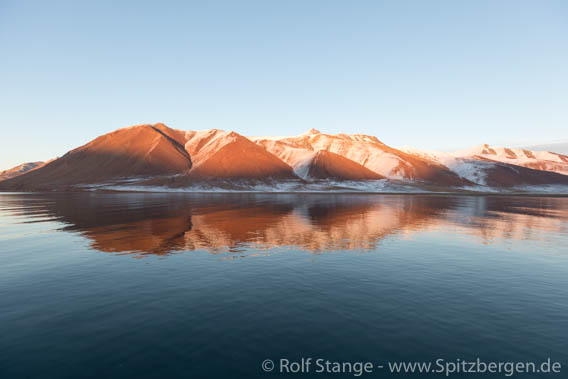
Moffen & Woodfjord – 16 September 2018
Sun
16 Sep
2018
The weather stays on our side, the sun is shining through the thin clouds and, even more important, the sea is almost flat like a mirror as we set course for Moffen in the early morning. Not too much later we are shore. Moffen! This little island just above 80 degrees north, hardly more than an extended gravel bank, it exerts a fascination that is hard to descrive with a few words. A little, lonely island in the polar sea, this almost bizarre landscape of series of old beach ridges which add up to one another to form a gravel ring around a lagoon, the charme of a forbidden island, it all comes together. Moffen is indeed a forbidden island, because you are not allowed to approach closer than 300 metres from mid May to mid September. Today it is 16 September, so you need not just the weather but also the calender on your side to get really close to the island.

Moffen is located exactly on 80° North.
And then there are the walrusses! There are more than 100 in 3 groups on the southern tip of the island, and more in the water. We have an amazing experience with them. It is hard to tell who is more curious, again and again there are walrusses swimming towards us, curiously checking the unusual visitors out.

Who’s watching who? Curious walruses on Moffen.
There is also plastic on Moffen, sadly, as almost everywhere. We take quite a lot of it with us.
Many of us have read Christiane Ritter’s book „A woman in the polar night“, for some us it was a poetic door-opener to the Arctic many years ago. We do have the chance to visit the hut near Gråhuken where the famous wintering took place. An almost emotional experience for some of us, and certainly interesting for everybody.

Christiane Ritter wintered in the Ritter hut in 1943/35. The hut was built in 1928 by the legendary Norwegian trapper Hilmar Nøis.
Finally we drop anchor in the bay of Mushamna – the lagoon itself is frozen, so we stay outside as we are not sure if provisions would last for a winter. We spend the evening around a fire on the beach, watching how the colours in the landscape change.

Murchisonfjord & Sorgfjord – 15 September 2018
Sat
15 Sep
2018
There must have been hundreds of Russian crosses in Spitsbergen centuries ago, built by the Pomors near their hunting stations. Nowadays there are only two of them left and still standing, both on little islands in Murchisonfjord. One of them is our destination for the morning.

Russian cross, Nordre Russeøya/ Murchisonfjord
Snow is lying on the ground and there is the smell of winter in the air, a feeling even enhanced by the yellowish light of the low sun. We take stunning arctic winter impressions and some large fishing nets back on board after the landing.

In Sorgfjord, the clouds have disappeared almost completely, the sun is low on the blue sky. The snow-covered land is shining in colours somewhere between white, blue and red.

Crozierpynten on the Eastern side of Sorgfjord

Murchisonfjord – 14 September 2018
Fri
14 Sep
2018
A reasonably calm night under sail brings uns far east to Nordaustland, as far as Murchisonfjord. A thin layer of fresh snow is a clear sign of the summer fighting a lost battle in these latitudes, the thermometre does hardly climb above zero anymore. A snow shower was reducing the visibility almost to zero as soon as we went ashore.

Snaddvika, Murchisonfjord
We landed in the innermost corner of Murchisonfjord. White snow was covering red rocks, greetings from early chapters of Earth history. Wide-open views over hills and valleys, fjords and islands, with the ice cap in the background.

Kinnvika, Murchisonfjord
We move over to Kinnvika for the afternoon landing. The September sun is casting warm light over the cold landscape and the old Swedish research setation. The light is getting more and more intensive, with colours like from an dream.
We spend the night at anchor in Kinnvika, nice and calm.

The Swedish research station Kinnvika was last in operation in 2007/2008.
From Smeerenburg to Hamiltonbukta – 13 September 2018
Thu
13 Sep
2018
A lovely bit of sailing takes us up to Smeerenburgfjord during the night. Smeerenburg gives us a friendly welcome with fine landing conditions. Walrusses, Dutch 17th century whaling, polar foxes and the beautiful scenery make the morning.

Walrusses, Smeerenburg
As we continue further eastwards, we see the first polar bear of the trip. Quite distant, but well visible for everybody.

The first polar bear of our trip!
In Hamiltonbukta, we enjoy the timeless beauty and silence of the Arctic for a while, surrounded by stunning mountains and glaciers. So, another good day in the Arctic! We are curious what tomorrow may bring, as we set course to the northeast.

Smeerenburg

Hamiltonbukta
Kongsfjord – 12 September 2018
Wed
12 Sep
2018
We start in rather traditional manner in Ny-Ålesund in Kongsfjorden. Our first and last visit to a settlement. Spitsbergen gives us a warm – well, chilly, but sunny and beautiful – welcome. A fresh breeze is coming towards us as we go alongside. We dedicate the morning to the little settlement with its history, coal mining and north pole expeditions, and the present: science.
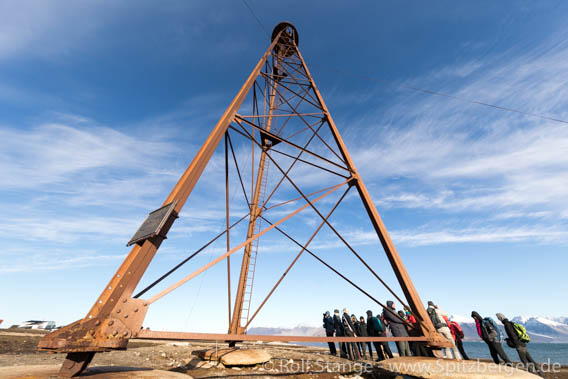
The mast from which Amundsen and Nobile launched their airships.
The large glacier Kronebreen is tempting us in the afternoon. We can’t resist – well, why should we even try – and enjoy the stunning landscape.
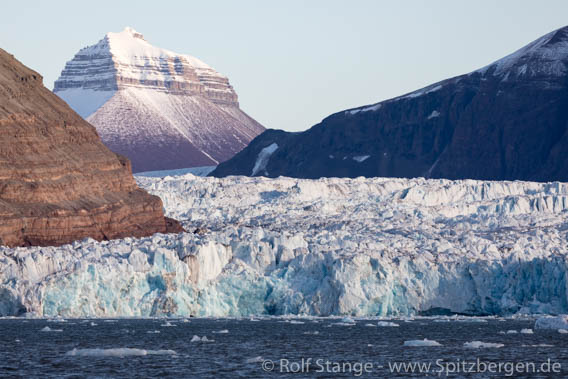
The mighty glacier Kronebreen
Later, we set sails again. It is pure pleasure to move silently out of Kongsfjorden and into the sunset.

Text: Rolf Stange
Isfjord – 11 September 2018
Tue
11 Sep
2018
It was high time to take off again, to get water under the keel and wind around the masts! We got a good bit of both as we went on board SV Antigua today. There was a fair breeze blowing out of Adventdalen, the sun was shining from a blue sky. Late afternoon, we left the small pier in Longyearbyen, and up went the sails!

Up went the sails! This time towards the west and north coast of Spitsbergen.

From Adventdalen into the Isfjord.
It was a beautiful bit of real sailing out of Adventfjord and through most of Isfjord. Many people on board have been on Spitsbergen a number of times before, so it should really be a very interesting trip!

Great guests and atmosphere on board!
The first evening made clear what September in Spitsbergen is all about: warm light from the low sun, stunning scenery and even a Blue whale which waved with its fluke.

A Blue whale, the biggest animal on earth…
We passed the wide plateau of Fuglefjella, Grumantbyen, Colesbukta. Mountains and glaciers on the other side in the north, Alkefjellet under the bright sun ahead of us. Amazing beauty wherever you looked!



Polar bear family in Bjørndalen near Longyearbyen
Today (Monday, 10 September), a polar bear family was seen near Vestpynten, not far from the airport and campsite at Longyearbyen. It was a female bear with two first-year cubs, probably the same polar bears that were seen on Saturday at Revneset, on the north side of Adventfjord opposite of Longyearbyen. On Saturday, the bears were chased away by helicopter towards Sassenfjord, away rom Longyearbyen.
Polar bears including females with cubs regularly cover large distances. A walk including longer swimming distances from Adventfjord (Longyearbyen) to Sassenfjord and back within 2 days is fully realistic and normal.
When the bears were seen near Vestpynten today around 16.00, both curious onlookers and the Sysselmannen (police) were soon on the scene, as reported by Svalbardposten. The Sysselmannen followed the polar bear family by car slowly towards Bjørndalen further west.
There, hopes that the bears might continue and disappear from the Longyearbyen area soon vanished in the haze, as the bears were seen feeding on a large whale carcass, possibly from a sperm whale as appears on a photo taken by the Sysselmannen. This might provide the bears in question with food for a longer period, if the whale does not start to float and drift away again. Chances are also that the whale carcass attracts further bears.
The Sysselmannen asks the public not to get close to the bears and to be alert and to exercise usual safety measures at any time in the field.
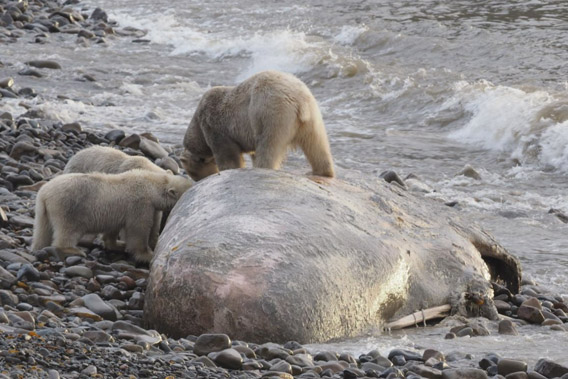
Polar bear family with a solid meal in Bjørndalen near Longyearbyen, Monday (10 September) afternoon. Photo © Sysselmannen.
Update: the polar bears were scared away from the whale carcass by the Sysselmannen later on Monday, as Svalbardposten wrote. The dead whale was towed into the fjord by Polarsyssel, the Sysselmannen’s ship, and the bears were scared and moved up into Bjørndalen.
The Spitsbergen-Calendar 2019 is available
Our already almost traditional Spitsbergen-calender ist now available for 2019. It is available as before in the bigger A3 format (beautiful on the wall) and the smaller A5 (great for example on the table or on the wall where not so much space is available).

With arctic impressions through the year: the new calendar Spitsbergen 2019 is now available.
As opposed to other offers available on the market, we select a set of 12 entirely new photos every year to create a completely new calendar with fresh impressions, showing some of Spitsbergen’s most beautiful sides including scenery, wildlife and flowers.

Unusual perspective of an impressive landscape: the ice cap Austfonna seen from the air.
Unusual perspectives of remote places together with stunning wildlife photos form a good part of the selection, which is completed by flowers and stunning scenery of polar landscapes and ice.

Of course there are some polar bears in the calendar 🙂
Click here to see all images of the Spitsbergn calender 2019, more information and ordering.
Job market in Longyearbyen growing in spite of reduction in coal mining
The great fear of a collapse of the job market in Longyearbyen after the significant reduction of coal mining, especially in Sveagruva, did not become reality so far. This is indicated by the latest statistics of the Statistik Sentralbyrå, the Norwegian directory of statistics. In 2017, there were 4.2 % more jobs in Svalbard compared to 2016. The number of jobs in mining were actually reduced by 34 % down to 100, but this loss was more than compensated by growth in other branches, mostly in relation to tourism. Hotels and restaurants created 36.3 % more jobs in 2017 than in 2016, totalling 315 jobs in 2015. ´
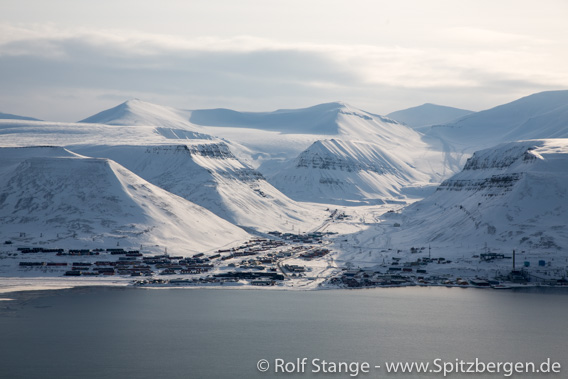
Longyearbyen is growing, also on the job market: 4,2 % more jobs in 2017.
This growth is measured in “Årsverk”, which may be best translated with “man hours per year”. 315 “årsverk” do not necessarily mean 315 full-time employees, but an amount of paid work that could be done by 315 people within one year. This amount of work may, however, be spread over a larger number of part-time or seasonal jobs, which is certainly the case to some degree in tourism. “Tourism” as such is not a category in the statistics. Jobs created within tourism are measured in categories such as hotels & restaurants, service industry and transport and logistics.
News-Listing live generated at 2025/June/15 at 05:39:40 Uhr (GMT+1)




























